Print knowledge
Children will strengthen their understanding of how to properly care for books.


Review:

Yesterday we learned what can happen when we do not take good care of books. What kinds of things happened to the book we shared yesterday?
[Support children in recalling 2–3 types of damage to yesterday’s book.]
Most books are made to last a long time. Books are to be used by different people. Books in our classroom may be used by anyone in our room. Books we borrow from a library may be used by other children when we return the book to the library. Some families give away books they no longer use.
[Display damaged book from Day 4.]
Let’s use our book from yesterday to talk about ways to take good care of a book.
[Use the damaged cover and pages to engage children in a discussion of how to properly care for books. Incorporate the following into the discussion:
We may look at a book that we do not like. Or we may look at a book that does not interest us.
Someone else might really like a book that we do not like. Remember, each of us is unique. We like different things.
We should take good care of all books, even books we might not like. Books are made to be used again and again by different people. Where do we put a book in our room after we have finished looking at it?
Extra support
Enrichment
Provide children with an assortment of books to look at and enjoy. Include the damaged book from the current session (and Day 4). Ask children to describe how to care for books.
Arrange a specific time at your local library for a librarian to talk with all children in your setting about the proper care of books.
Number knowledge
Children will deepen their understanding of the concepts of number and counting, and that numbers are all around us.


Review:

We are learning about numbers and counting. We count things to find out how many. We use numbers when we count.
Remember, a number tells us how many. One is a number. Two is a number.
We use numbers to tell how old we are.
[Hold up three fingers, four fingers, five fingers as you say ages. Omit five years if there are no five-year-old children in your classroom.]
Some of us are three years old. Some of us are four years old. Some of us are five years old.
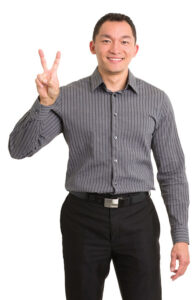 We can use our fingers to show how old we are.
We can use our fingers to show how old we are.
[Encourage children to count with you as they point to or hold up one finger for each year of their age.]
Let’s count together: one year, two years, three years, four years, five years.
Now let’s show each other with our fingers how old we are.
[Encourage children to look at how many fingers their peers are holding up.
Place 1–5 bottles of glue in front of you. Another common classroom item may be used if glue bottles are not available.]
Please count with me to find out how many bottles of glue are in this group.
I will point to each bottle as we count. We will say a number each time I point to a bottle of glue.
[When you finish counting, say the final number.]
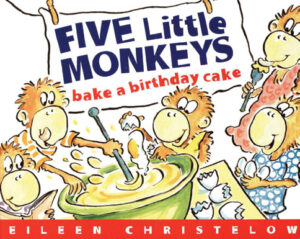 On Day 2 we read a book that helped us practice counting.
On Day 2 we read a book that helped us practice counting.
[Display book cover.]
We counted the number of monkeys on each page of our book. Let’s look again at several pages and count together the number of monkeys.
[Select several pages that are appropriate to children’s counting skills and count together the number of monkeys on each page.]
Let’s count from one to five while clapping our hands. We will clap once for each number we say.
[Adjust the pace of counting according to children’s counting skills.]
We are learning how to tell how many without counting. We look quickly at a small group of things and know how many there are.
[Quickly hold up and then hide 2–5 fingers, depending on children’s counting skills.]
How many fingers did I hold up?
[Show again the number of fingers you held up and lead children in counting as you point to each finger. Say again the number of fingers when you finish counting.
Repeat the process with a different number of fingers. Engage children in counting as you point to each finger. Be sure to say the number of fingers again when you finish counting.]
This week we learned to count items in a small group. We also practiced looking at a small group and labeling the number of items without counting. We know that numbers are all around us. Who sees something in our classroom that we could count?
Extra support
Enrichment
Invite children to explore building in the block center two small structures that differ in the number of blocks used. Example: One tower with two blocks and another tower with five blocks.
Encourage preschool-age and school-age children to count items throughout the day. Examples: Count snack items at snack time, count crayons in a box, count buttons on a shirt. Encourage preschool-age children to count a group of items and then encourage school-age children to add to the number of items to achieve a group of a given number. Example: “Clara counted four crayons on the table. Nickolas, how many more crayons do we need to make a group of eight crayons?”
Good health practices
Children will understand proper handwashing steps and when to wash their hands.


Review:
Be Prepared: The activity extends yesterday’s focus on germs by providing an opportunity to review your classroom’s rules for handwashing. Use existing handwashing posters in your classroom or center for the activity. Two posters are offered for your use if classroom or center posters are not readily available. Describe your classroom’s procedures, which may differ from the information offered below. Adapt information in this plan to represent your classroom’s practices.
Yesterday we read a book about germs and what we can do to protect ourselves from germs. Remember, germs are small, but powerful. Remember, the word power means that something can make things happen. Germs can make us feel sick.
How can we protect ourselves from germs? (wash our hands, cover our mouth when we sneeze or cough)
Please watch me put my hands under some water at our sink.
[Run your hands quickly under water at the handwashing sink in your classroom. Do not use soap. Do not scrub or rub your hands. Do not use a paper towel. Make sure all children can see your actions.]
Today we are going to talk about good ways to wash and dry our hands.
We have a poster to remind us of the right way to wash our hands.
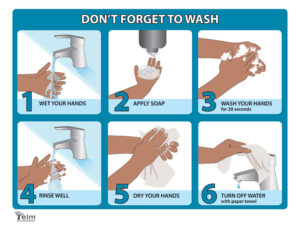 [Display your classroom’s poster of handwashing steps or use the provided Don’t Forget to Wash poster.
[Display your classroom’s poster of handwashing steps or use the provided Don’t Forget to Wash poster.
Point to and read each step. Describe the step in your own words. Demonstrate the action shown in the step and encourage children to do the action (pretend).]
[At the conclusion of reviewing each step on the poster, point to step #3:]
Our poster says to wash our hands for 20 seconds. There is a simple way for us to know how long 20 seconds lasts. We can sing a short song about washing our hands. We wash our hands during all of the time we sing our song. Our song lasts for 20 seconds. We know we have washed our hands for 20 seconds when we finish the song.
I will sing the song to you. Then we can sing it together.
[Sing the song slowly and say the words clearly as you do the matching hand motions. Then invite children to join you in singing the song again.
Remind children of the two songs suggested in the book used on Day 4. Each of the songs should be sung twice while washing their hands.]
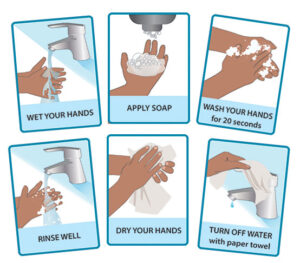 There is a game we can play with cards that show the steps we use for washing our hands.
There is a game we can play with cards that show the steps we use for washing our hands.
[Display and describe each of the six cards in their proper order. Emphasize order in your discussion. Spend more time describing each step if the steps on the cards differ somewhat from your classroom’s poster.]
We are going to mix up the cards and then find out if we can put the cards in the right order.
[Spread the cards face up in random order so all children can see them. Ask for volunteers to pick out the card that shows the first step of washing our hands. Continue until the six steps are in order. Invite different children to participate in selecting each card (step) so the activity is not dominated by a few children.]
We are reminding ourselves of the right way to wash our hands. Now let’s remind ourselves of when we should wash our hands.
What are some times we need to wash our hands at our center and when we are at home?
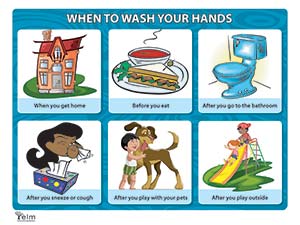 [Display your classroom’s poster of when children are to wash their hands or use the provided poster as a visual for this discussion.
[Display your classroom’s poster of when children are to wash their hands or use the provided poster as a visual for this discussion.
Point to the poster’s picture that corresponds to children’s responses. Use the poster pictures as reinforcement.]
Today we reminded ourselves of how to wash our hands the right way. We learned a little song to help us wash our hands for 20 seconds. We also reminded ourselves of when we should wash our hands. What are we getting rid of when we wash and dry our hands the right way? (germs) What can germs do? (make us sick)
 Extra support
Extra support
Enrichment
Provide the *handwashing sequence cards. Encourage children to work with a friend to put the cards (steps) in the right order.
*Printables provided
To help all children in your setting understand how easily germs can spread, use small pieces of masking tape or a sticky note to mark places that children touch during a play period (or part of a play period). At the end of the play period, talk with children about all of the places where germs may have been left during play time. Emphasize how washing our hands can help keep germs from spreading.
Respecting Our Differences
Social Studies
Skill and Goal
Individual diversity
Children will identify their unique physical characteristics.
Materials
Needed
Key
Concepts
New:
Optional
Reading
We are learning that we are all the same and different. Each one of us is unique in our very own way. Unique means that there is no other person just like you.
Today each of us will create a tracing of ourself.
We will each have a chance to lie on the floor so someone can trace our body.
[Invite each child to lie down on a piece of butcher paper as an adult traces his/her body. As children wait their turn, they may enjoy quietly pretending to trace their body. As you trace each child, comment on parts of the tracing. Example: “Did you know you are so tall?”
Briefly mention similarities and differences as you trace children. Example: “I see that Chandelle’s head is different than Marco’s head. How are they different?” Gather children again into a larger group when tracings are complete.]
Together we created tracings of our whole group today! We are all in the same classroom. But we don’t look the same, do we? Each of our tracings shows how unique we are. No two of us are exactly alike. During center time today we can make our tracing look like ourself. We can use markers and crayons to make our face or clothes.
Scaffolding Tips
Extra support
Enrichment
Center Activity
Provide crayons and markers for children to use in adding features to their tracings. Also, provide non-breakable mirrors for children to use as they draw their facial features. Hang the tracings where they are visible in the classroom or hallway.
Family Child Care
Provide children with a piece of paper with the title, Things I Like. Provide several pre-chosen magazine pages of items that are appropriate for young children and scissors. Invite preschool-age children to cut out pictures from the magazine pages of things they like and glue them to the paper. School-age children may enjoy drawing additional items on their paper. Display the papers in your setting when they are finished. Ask children to describe why they like each thing. If time permits, transcribe preschool-age children’s narration and post with their creations. School-age children will enjoy writing their own descriptions.